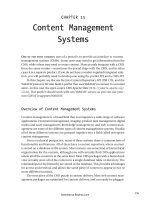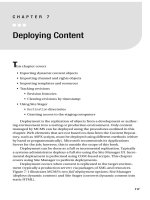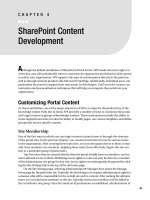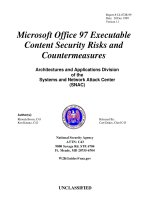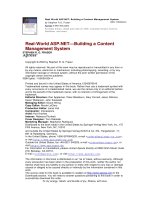semrush cmi content research
Bạn đang xem bản rút gọn của tài liệu. Xem và tải ngay bản đầy đủ của tài liệu tại đây (1.21 MB, 35 trang )
The Invisible
Key to Content
Success
The Importance of
Data Consolidation,
Collaboration
& Workflow
Biggest Content Challenges of
2018 and How to Address Them
2 / 35
Сontent has proven to be one of the most powerful marketing tools. However, even the
content marketing practitioners that have risen to immense heights in their profession,
still have to work hard and strive to make sure the result of their efforts meets both
business needs and the expectations of their target audiences.
At SEMrush, we know what it takes to produce and manage large amounts of content. We are also constantly working on the development of a comprehensive toolkit
to help content marketers of all skill levels reach their goals with minimal effort. That
is why we decided to identify the biggest challenges to highlight the main bottlenecks
for content marketers across different stages of the content lifecycle and gain a better
understanding of what solutions might help them to overcome those challenges.
We teamed up with the Content Marketing Institute, and our work with them resulted
in a research that we are excited to share with you.
The results of this research supported our main hypothesis concerning the issues that
hold back content strategists, content writers, editors, project managers, and PR/marketing managers. The Whitepaper below contains our findings and insights on how to
address these difficulties at all steps of the workflow.
We plan to use this data to bring our tools to perfection. In addition, we hope this
Whitepaper will help content marketers to better understand which part of their workflow can be optimized to make the most of their content.
3 / 35
New research finds that
consolidating the content
lifecycle through data, tools
and better collaborative
workflow may be the most
important part of a digital
content marketing strategy
By Robert Rose
Chief Strategy Advisor,
Content Marketing Institute
Table of contents
Introduction
The Need for People to Power Technology
The Challenges to the Design
Methodology & Approach to the Research
The Process of Strategic Content
Findings
Planning & Ideation
Creation & Optimization
Distribution
Perfomance Tracking & Audit
Unified Content Collaboration and Planning
Conclusion
The Invisible Magic of A Collaboration Strategy
About SEMrush
Introduction
The Invisibility of Great
Content Marketing Strategy
There is a wonderful quote by Jared
Spool, the American writer, researcher
and educator on the subject of usability
in software design. He said “good design,
when it’s done well, becomes invisible.
It’s only when it’s done poorly that
we notice it.”
Digital content and marketing practitioners strive for creative and powerful user
experiences. If anything, the marketer’s
job is to make things that stand out in
a crowd. Marketers want audiences to
notice the content, to click on it, to be
impacted by it, and to ultimately be persuaded by it.
The digital marketer’s instinct is to make
sure that as much of the budget as possible is spent toward things that the audience will see. But a focus on “standing
out”, especially when combined with limited time, budgets and headcount, can lead
marketers to unfortunately deemphasize
some of the things that need
to be designed well, but don’t initially
appear to help the brand stand out in
6 / 35
the marketplace of ideas. In other words,
in many cases, marketers would rather
spend money on the design of the new
house, rather than ensuring the plumbing
works well.
Content Marketing Institute conducted
research in 2017, and found that only 9%
of marketers have developed a completely systematic approach to producing,
managing, and distributing content. Most
marketers (69%) said that while there are
“some systems in place, there is still a
lot of manual work.” Further, CMI found
that only half (53%) of marketers have
any kind of “formal workflow process” for
planning, creating and delivering content.
Many organizations are simply not invested in this invisible, yet crucial infrastructure. In CMI’s 2017 study, was found that
only 17% of Content Marketers felt that
their businesses had the right technology
in place to manage content marketing
efforts. Further, almost half (45%) said
that while they “have the tools”, they aren’t
using them to their potential.
The Need for People
to Power Technology
A great content strategy is not, however,
simply a technology challenge. That “systematic approach” is ultimately a people
challenge. At Content Marketing World
in 2017, CMI assembled a round table of
experts who found that a common understanding and collaboration were one
of the biggest challenges to success with
content. Carla Johnson, president of Type
A Communications and my co-author on
the book Experiences: The 7th Era of Marketing put it succinctly. She said “the first
thing I see is people don’t agree with
what you’re trying to accomplish with
content marketing. Having a clear and
common purpose or mission that everyone is behind and supports is probably
the biggest solution I see to overcoming
the bottlenecks.”
Additionally, a common access point
to data can be the system to drive this
common purpose or mission. In a recent
study we just conducted at CMI, we
7 / 35
found that of the Content Marketers that
were strategically aligned with Sales and
executives, 79% of them had access to
a shared content and data repository.
Among those who had low alignment
with sales teams and executives, only
55% of them had this shared access.
These ideas of a common understanding,
and shared access to data was underlined in an article in Harvard Business
Review written by General Electric’s Vice
Chair Beth Comstock, called Unleashing
the Power of Marketing. In the article,
Comstock talks about how GE created a
marketing framework that helped create
a unified mission across all the different
groups. This mission was created along
three dimensions: “principles (creating a
common language and standards, people (getting the right leaders in place),
and process (including very specific
measures and systems for grading
performance).”
8 / 35
The Challenges to the Design
To be clear, marketers seem to understand
there is a need for better collaboration and
communication. There is a broad acknowledgement and recognition that marketers
need to take more time and invest in the
“invisible” infrastructure that can help make
a content marketing strategy more successful. In CMI’s 2017 study of marketers
and content strategy, was found that 66%
of marketers said that “better using technology to manage content as an asset”
was their primary educational need. Further, 64% said that “how to build a scalable content strategy” was the secondary
priority in education.
So, if marketers understand that there is
a challenge, where should they begin to
solve it? This question, led us to design a
research project that would help us uncover some of the answers. Specifically, we
wanted to know:
Where, specifically, are
the challenges with the
different parts of
the content lifecycle?
9 / 35
SEMrush, the digital marketing toolkit for SEO, PPC, SMM and Content Marketing professionals, – in partnership with The Content Marketing Institute — set out to study the current state of content workflow at the individual practitioner level. We sought to examine
the current challenges of a number of internal personas and the content management
process. These personas include:
Content
Strategist
Editor
Content
Writer
Project
Manager
We asked about the specific challenges
of each persona at each part of a content
strategy workflow.
To accomplish this, SEMrush and CMI
designed a survey for these practitioners
and fielded it to the SEMrush and CMI
Marketing Audiences. For purposes of
this research, these personas were defined as individuals who self-identified
with the title or function of the persona
as indicated.
In particular, in this research we aimed to
understand the cross-functional challenges at all steps in the workflow. In short:
we wanted to identify the bottlenecks and
challenges across the team, and across
the workflow - not at just one particular
persona or stage. Which tasks are most
PR/Marketing
Manager
time consuming? Which tasks are most
challenging? How are topics decided?
Who do you collaborate with? What tools
are in place? Is automated scheduling in
place? What would help you to do your
job better?
Our overall findings support the following
hypothesis: strategic content marketing
is being primarily held back by a lack of
shared access to data, and technology
that unifies this analysis, and facilitates
better internal communication.
In summary: the invisible design of
better access to data, infrastructure
and workflow technology will help
teams communicate and create a more
successful content marketing approach.
Methodology
& Approach to
the Research
11 / 35
Methodology & Approach
to the Research
In the Fall of 2017, SEMrush, in partnership with CMI, conducted an electronic survey
of randomly selected content practitioners from its broader audiences. A total of 1,884
surveys were completed from qualified content practitioners around the world.
The overall makeup of the respondents are reflected in Fig. 1.
Content
Writer
Content
Strategist
Editor
PR Manager
Project
Manager
0%
10%
20%
30%
40%
50%
Figure 1 - Self-Identified Roles Of Survey Respondents
60%
70%
80%
12 / 35
The Process of
Strategic Content
Then, as part of this research, SEMrush utilized a four-step workflow process as a baseline reference point for each of the different personas (Fig 2). This process includes:
Planning &
Ideation
Creation &
Optimization
Distribution
Perfomance
Tracking & Audit
Figure 2 - The Lifecycle Of Content
Planning & Ideation – This includes
the editorial planning, the process of
researching and choosing topics on
which to create content, and the overall strategic planning.
Distribution – This includes the publication of content to any media property. This could include owned properties such as Email, Web sites, or blogs,
as well as the promotion and/or re-use
of content across other distribution
channels (e.g. other blogs, websites,
social media, mobile etc..).
Creation & Optimization – This includes the actual writing and editing
process of the content, as well as the
design, optimization for search engines, and production aspects of the
finished projects.
Performance Tracking & Audit – This
includes the measurement strategy,
and process of looking at the performance of content, as well as auditing
the internal processes of the effectiveness of the content strategy.
We have structured this report to examine the findings from the different content practitioner personas across each of these stages.
Findings
14 / 35
Planning & Ideation
Editorial planning and the process of deciding which content to create can be one
of the most challenging parts of the content workflow process. And, many times
this is the part of the process that gets
the shortest straw in terms of investment.
In this particular research, we found that
there were some interesting challenges
here among the different personas.
When we asked, overall, about the most
Deciding what
to write about
time-consuming aspect of the content
lifecycle, Content Strategists identified
“creating a content plan” as the top
answer. Just over 36% of the Content
Strategists said that planning was the
most time-consuming part of their effort
across the entire process (Fig 3). PR/Marketing Managers seemed to agree, saying
that “deciding what to write about” was
the second highest time-consuming task,
with 26% mentioning it.
22%
Creating a
content plan
37%
Defining the ROI of
a content campaign
25%
Creating reports
for clients/chiefs
12%
Other
4%
0%
10%
20%
30%
40%
50%
60%
Figure 3 - Most Time-Consuming Tasks For Content Strategists
70%
80%
15 / 35
Project Managers defined “planning and
resource management" as the most challenging of their tasks - just over 42% mentioned it as being their biggest challenge.
The Content Strategist is certainly the role
one would assume would lead and/or
manage the Planning and Ideation stage.
And, when we examined this a bit closer,
we revealed an interesting gap between
the most time-consuming task vs. the
most challenging aspect of being a
Content Strategist.
When we asked Content Strategists what
Creating a
content plan
their most time-consuming task was, as
mentioned previously “creating a content plan” was mentioned the most often
at 36% (Fig 3). However, when we asked
about the most “challenging” aspect of
being a content strategist, “creating a content plan” was actually among the lowest
responses, with only 12.6% mentioning
it as the biggest challenge. Interestingly,
here, “developing the content pieces that
resonate with target audiences”, and
“developing an ROI plan” were the top
two “most challenging” responses by far at
33% and 25% respectively (Fig 4).
13%
Developing an
ROI plan
25%
Reporting or
Analytics
11%
Finding/
Researching the most
prominent topics
16%
Developing the content
pieces that resonate
with our target audience
33%
2%
Other
0%
10%
20%
30%
40%
50%
60%
Figure 4 - Most Challenging Tasks For Content Strategists
70%
80%
16 / 35
COMMENT: These top three most challenging tasks at the planning stage can be
summarised in one point - it can be difficult to guess how effective and useful content
is going to be and whether it will help in achieving the desired goals. Despite content
planning and ideation being partly a creative process, the importance of access to
consolidated data for content marketers, which can help them to remove the guesswork and analyze their own and their colleagues’ previous activities, is undeniable. And
this analytical element, unlike the creative part, is usually the most difficult one due to
the lack of consolidated and relevant data.
These results suggest that there may be
an opportunity for those Content Strategists that are tasked with leading the Planning and Ideation portion of the content
lifecycle to share some of the planning
aspects. There may be a higher need for
understanding and sharing of the overall
content planning tasks, so that the Strategists can spend more time determining
business goals and researching/developing the content pieces that will resonate
with their target audiences.
Content Strategists should ask themselves if there might be a mechanism to
communicate and/or collaborate some of
the content plan development with their
colleagues, so that they might be able to
balance their overall work and priorities to
getting to better content.
This brings us to the second part of the
content lifecycle.
17 / 35
Creation & Optimization
The content creation and optimization
stage is where content is written, edited,
designed and ultimately produced for
publication. Over the last few years, we
have certainly seen brands try to focus
on a more qualitative vs quantitative approach to the production of content.
The roles that typically have responsibility for the creation and optimization of
content are, of course, the Editors and the
Content Writers.
Generally speaking, across the roles, we
found that the average number of content pieces that are being produced on a
monthly basis was somewhere between
Understanding
the target audience
and its problems
6 and 15 pieces. The second highest
answer was between 3-5 pieces on a
monthly basis.
When asked about their biggest challenge, almost half of the Content Writers
noted that their biggest challenge was
“finding a balance between the creative element and search optimization in
content”. And, further, almost four out of
ten (37%) said that “understanding the
target audience and its problems” were
the most difficult part of content creation
(Fig. 5). Editors, in its turn, mentioned
“editing drafts” as their main time-consuming task.
38%
Creation of article
structure
15%
Finding a balance
between the creative
element and search
optimization in content
47%
Keeping track
of deadlines /
Time management
17%
Finding the right
expressions and
figures of speech
14%
Other
7%
0%
10%
20%
30%
40%
50%
Figure 5 - Most Challenging Tasks for Content Writers
60%
70%
80%
18 / 35
We then examined with whom the above mentioned interact most often, and discovered
that a lot of “collaboration” happens between different team members. Almost half of
the Editors defined “Content Writers” and “Designers” as persons they collaborate with
the most often - 48.6% and 24.3% respectively. And for the Content Writers these people
are “Content Strategists” - 27.5%, “Project Managers” - 24.9%, and “SEO Specialists/Analysts” - 23.8% (Fig. 6).
Content
Strategist
27%
Project
manager
25%
SEO Specialist /
Analyst
24%
2%
SMM Specialist
10%
Proofreader
14%
Designer
Other
19%
0%
10%
20%
30%
40%
50%
60%
70%
80%
Figure 6 - Most frequent collaborations
COMMENT: Content is one of the main
factors that determines your position
in Google’s search results. This leaves
content marketers with no choice but
to balance a creative approach with the
requirements of the search engines in
writing a good piece of content. The secret to success lies beyond just traditional keyword research. First, it requires a
deeper analysis of audiences’ interests in
particular topics and, most importantly,
questions they ask about them. Second
is an understanding of how to structure a
content idea and what vocabulary to use
that can both influence position in Google
and resonate with a target audience. Third
is paying attention to the semantics used
in texts, as for some time Google has taken into account the meaning of the whole
sentence, not just particular words, and
prioritises content that is relevant to people's interests.
19 / 35
In addition, content pieces/projects usually require a team of 2-3 people and it
takes time to make sure that everyone is
following the deadline, and on the same
page in terms of the goal of the content
piece/project.
All of the above mentioned requires consolidation in terms of data analysis and
the work of different team members.
These are challenges that would almost
assuredly be better addressed in a more
collaborative Planning and Ideation
phase, at which are revealed such things
as audiences’ interests, what type of content resonates most and other valuable
insights. So the goal is to create a system
of communication and consolidation that
can enable more effort toward understanding the target audience, finding the
SEO balance, and clarifying the editorial
focus for the content writers.
20 / 35
Distribution
Publishing and distributing content
across channels remains one of the biggest challenges for content practitioners.
Many businesses are still trying to determine the best strategies for this. In fact, in
CMI’s yearly Content Marketing Research,
“Content Promotion/Distribution” is the
second highest activity that businesses
still outsource.
In this particular research, we found
some interesting insights, especially
Track where my
competitors publish
their content
when it came to using content on external distribution channels. The PR/Marketing Manager role is the one most likely to
lead this, and when we ask how they find
resources (media/blogs) for publishing
their content, the highest percentage by
far was to “monitor what media/blogs
are writing about my industry” (Fig 7).
Almost three-quarters of the PR/Marketing Managers use this method to find
resources to publish their content.
31%
Monitor what the media/
blogs are writing about
my industry and make
a list of the most relevant
74%
Target familiar media
even if they are
not direct contacts
14%
Analyze what resources
performed best during
the previous campaign
50%
5%
Other
0%
10%
20%
30%
40%
50%
60%
70%
Figure 7 - How PR/Marketing Managers Find External Content Platforms
80%
21 / 35
Then, the second highest consideration
was to “analyze what resources performed best in a previous campaign”.
Almost half of the PR/Marketing Managers are using this technique to determine
which resources to publish content to. Interestingly, only 30% are actually tracking
where competitors are actually publishing
and using that as a resource to target
their content.
When we asked how these PR/Marketing
Managers evaluated the authority of the
resource they were planning to pitch for
this external content, the top two answers were tied in priority. Determining
the source’s “brand reputation” and the
“estimated monthly traffic” were equally
important for these content practitioners
to evaluate the source’s authority (Fig 8).
By their brand
reputation
45%
By estimated
monthly traffic
of the resource
45%
By Domain
Authority
38%
Other
7%
0%
10%
20%
30%
40%
50%
60%
70%
80%
Figure 8 - How PR/Marketing Managers Evaluate The Authority Of An External Resource
22 / 35
Among these PR/Marketing Managers, when we asked what consumed the most
time for them, interestingly “defining ROI” and “deciding what to write about” were
the two largest tasks for them at (30% and 26% respectively). “Finding a place to publish content” was only mentioned by 19% of the PR/Marketing Managers as being a
time-consuming task (Fig 9).
Deciding what
to write about
26%
Finding a place to
publish content
19%
Finding a person to
whom I can pitch content
12%
Defining the ROI of
campaign/activities
31%
Creating reports
for clients/chiefs
5%
7%
Other
0%
10%
20%
30%
40%
50%
60%
70%
Figure 9 - Most Time-Consuming Tasks for PR/Marketing Managers
80%
23 / 35
Considering these challenges, we also wanted to establish whether PR/Marketing
Managers cooperate on these tasks with other team members, and what are their
roles. The statistics showed us that PR/Marketing Managers communicate most often with “Marketing Analyst/Researcher” at 38%, followed by “Content Writer” at 30,9%;
the third is “Content Strategist at 28.6%” (Fig. 10).
Content
Strategist
28%
Project
Manager
24%
Content
Writer
31%
Marketing Analyst /
Researcher
38%
5%
SMM Specialist
2%
Proofreader
19%
Designer
Other
7%
0%
10%
20%
30%
40%
50%
60%
70%
80%
Figure 10 - Most frequent collaborations
COMMENT: Content distribution requires
smart analytics and the evaluation of
different resources’ potential, as well as
planning which content will work best for
a particular resource and its audience.
This means that content marketers need
to process a lot of data and information
to make a final decision about where to
publish content, what content it should
be and what should be the ROI of the
content. If content professionals can
access a “single source of the truth” when
it comes to the audience’s interests and
relevant resources, they may be able to
shorten the time needed to analyze the
best channels.
24 / 35
Moreover, at this workflow stage there may be a big opportunity for closer collaboration with other team members, like Content Strategists and Marketing Analyst/Researcher during the Planning and Ideation phase, as well as with Content Writer during
the Creation & Optimization phase to save these PR/Marketing Managers effort in
terms of where they are spending their valuable time.
And measuring the output of that valuable time brings us to the last phase of
the content lifecycle.
Performance
Tracking & Audit
We at CMI have found that year after year,
measuring performance and results is
truly the most challenging content task
facing most businesses today. In the
2018 version of CMI’s yearly research, we
found that only 19% of content marketers
rated their alignment of metrics and goals
as “excellent” or “very good”.
As we mentioned earlier in the report,
Content Strategists mentioned “developing an ROI plan” as being one of their
biggest challenges. Similarly, among the
PR/Marketing Managers, “defining the
ROI of campaign/activities” was the
25 / 35
most time-consuming task of everything
the PR/Marketing Managers are doing.
When we asked Content Writers if they
personally monitored the performance
of their content an overwhelming 82%
said “yes”.
We then dug a bit deeper and asked what,
specifically, organizations tracked as part
of their overall strategies. Everything from
website traffic, to number of leads, to
search engine positioning and even social
shares and bounce rate ranked in priority.

